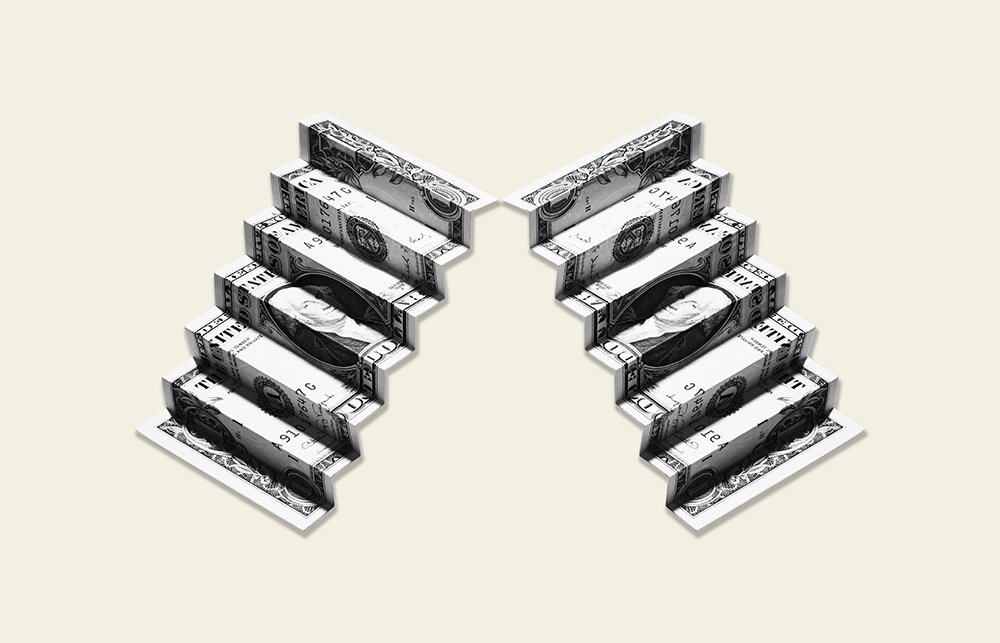
过去一年,白宫之争、美国参议院控制权之战和新冠疫情造成的破坏占据了各大媒体的头版头条。然而,一项巨大的财政困境却很大程度上避开了公众的监督:联邦政府越来越难以为它所做的和想做的一切提供资金。
即使遭到新冠疫情破坏的经济已开始复苏,联邦政府的平均年度预算赤字也将达到2万亿美元,相当于总税收收入的40%。在政治压力的推动下,政府开支将进一步走高,而中产阶级的税收将进一步降低。新任总统拜登曾表示,他计划提高对高收入阶层的税收,但共和党肯定会反对。
其实,有一项切实可行的解决方案,可以在不引发两党争执的情况下解决这一困境:追查逃税。2019年,美国纳税人逃税的金额高达5740亿美元,比收入后90%的个人纳税人所支付的税款总额还要多。如果我们仅仅只增加税收,而不修补税收系统的漏洞,那么只有已经依法纳税的纳税人会承担增税的压力。
这既不公平,也不利于维系税收系统。
追查逃税可以让税收工作更公平、更容易,还能在未来十年里为联邦政府增加1.4万亿美元的收入,而且其中大部分都来自未缴纳一分一厘应缴税款的高收入人群。这一金额超过了拜登提出的提高个人所得税计划。联邦政府加强税收合规的举措也会带动州政府、地方政府的收入增加。
我们追查逃税的计划包括三个部分:改善美国国税局的信息收集方式,开发技术帮助国税局充分利用收集到的信息,增加针对高收入纳税人的检查。
大多数纳税人不需要接受审计,因为他们会收到雇主提供的W-2表、银行提供的1099表或其他报表。这些信息可以帮助纳税人准确报税,同时方便国税局切实检查合规情况。雇主和银行申报的收入中95%得到了纳税人的正确申报,但第三方机构申报的收入(如大多数业务收入)中只有45%被申报纳税。此外,美国有一种将公司收入视为个人收入的企业(pass-through business,部分为合伙制),此类企业产生的总收入高达1万亿美元,但却往往是税收系统的漏网之鱼,缺乏第三方申报,审计率几近于零。
我们可以修补第三方向国税局申报各种收入时存在的漏洞,用一种高效的方式大幅加强纳税人和国税局的合规性。
独立监察机构近期的报告支持了这一结论。美国财政部税务管理监察长和政府问责局已经表明,政府可以通过更有效地利用第三方申报,向高收入纳税人征收数十亿美元。一份报告显示,几百名欠税高达100亿美元但未提交纳税申报表的纳税人甚至没有受到国税局的追究。
更新国税局过时的技术将有助于国税局利用一切可用信息,更准确地快速评估所有纳税申报表,找出其中的缺漏,并提高审计工作的效率。
我们提出的技术更新计划也有利于国税局借助更快速、更便捷的通信方式提高服务质量。如果此前做好技术能力建设,联邦政府本可以更有效地落实新冠疫情救助措施,包括现金分发和小型企业贷款。
我们的计划将创造一个更加精简、重点更明确的执行过程。如今,有钱人和受到审计的纳税人大相径庭。假设一个人住在密西西比河三角洲、收入2.5万美元,而另一个人住在纽约公园大道、收入几百万美元,那么前者受到国税局审计的概率将会大于后者。
我们的计划一开始的确会增加政府开支,但随着时间的推移,它将带来相当于成本15至20倍的收入,同时提高税收系统的公平性和可持续性。
联邦预算调整工作即将开始,我们可以抓住这个绝佳的机会,为国税局提供追查逃税所需的方向和资源,包括增加技术改善、人员任用经费和预估未来十年有望增加的相关收入。
拜登强调,两党应合作解决问题。按照我们的提议修补税收系统的漏洞,将有助于联邦政府着手解决当下面临的最大困境之一。(财富中文网)
弗雷德•戈德堡(Fred Goldberg)曾在老布什执政期间担任美国国税局局长。
查尔斯•罗萨提(Charles Rossotti)曾在比尔•克林顿和老布什执政期间担任美国国税局局长。
译者:钱功毅
目前美国存在大量逃税,而且其中大部分都是高收入人群本应缴纳的税款。图片版权:大卫•亚奇(David Arky),盖蒂图片社
过去一年,白宫之争、美国参议院控制权之战和新冠疫情造成的破坏占据了各大媒体的头版头条。然而,一项巨大的财政困境却很大程度上避开了公众的监督:联邦政府越来越难以为它所做的和想做的一切提供资金。
即使遭到新冠疫情破坏的经济已开始复苏,联邦政府的平均年度预算赤字也将达到2万亿美元,相当于总税收收入的40%。在政治压力的推动下,政府开支将进一步走高,而中产阶级的税收将进一步降低。新任总统拜登曾表示,他计划提高对高收入阶层的税收,但共和党肯定会反对。
其实,有一项切实可行的解决方案,可以在不引发两党争执的情况下解决这一困境:追查逃税。2019年,美国纳税人逃税的金额高达5740亿美元,比收入后90%的个人纳税人所支付的税款总额还要多。如果我们仅仅只增加税收,而不修补税收系统的漏洞,那么只有已经依法纳税的纳税人会承担增税的压力。
这既不公平,也不利于维系税收系统。
追查逃税可以让税收工作更公平、更容易,还能在未来十年里为联邦政府增加1.4万亿美元的收入,而且其中大部分都来自未缴纳一分一厘应缴税款的高收入人群。这一金额超过了拜登提出的提高个人所得税计划。联邦政府加强税收合规的举措也会带动州政府、地方政府的收入增加。
我们追查逃税的计划包括三个部分:改善美国国税局的信息收集方式,开发技术帮助国税局充分利用收集到的信息,增加针对高收入纳税人的检查。
大多数纳税人不需要接受审计,因为他们会收到雇主提供的W-2表、银行提供的1099表或其他报表。这些信息可以帮助纳税人准确报税,同时方便国税局切实检查合规情况。雇主和银行申报的收入中95%得到了纳税人的正确申报,但第三方机构申报的收入(如大多数业务收入)中只有45%被申报纳税。此外,美国有一种将公司收入视为个人收入的企业(pass-through business,部分为合伙制),此类企业产生的总收入高达1万亿美元,但却往往是税收系统的漏网之鱼,缺乏第三方申报,审计率几近于零。
我们可以修补第三方向国税局申报各种收入时存在的漏洞,用一种高效的方式大幅加强纳税人和国税局的合规性。
独立监察机构近期的报告支持了这一结论。美国财政部税务管理监察长和政府问责局已经表明,政府可以通过更有效地利用第三方申报,向高收入纳税人征收数十亿美元。一份报告显示,几百名欠税高达100亿美元但未提交纳税申报表的纳税人甚至没有受到国税局的追究。
更新国税局过时的技术将有助于国税局利用一切可用信息,更准确地快速评估所有纳税申报表,找出其中的缺漏,并提高审计工作的效率。
我们提出的技术更新计划也有利于国税局借助更快速、更便捷的通信方式提高服务质量。如果此前做好技术能力建设,联邦政府本可以更有效地落实新冠疫情救助措施,包括现金分发和小型企业贷款。
我们的计划将创造一个更加精简、重点更明确的执行过程。如今,有钱人和受到审计的纳税人大相径庭。假设一个人住在密西西比河三角洲、收入2.5万美元,而另一个人住在纽约公园大道、收入几百万美元,那么前者受到国税局审计的概率将会大于后者。
我们的计划一开始的确会增加政府开支,但随着时间的推移,它将带来相当于成本15至20倍的收入,同时提高税收系统的公平性和可持续性。
联邦预算调整工作即将开始,我们可以抓住这个绝佳的机会,为国税局提供追查逃税所需的方向和资源,包括增加技术改善、人员任用经费和预估未来十年有望增加的相关收入。
拜登强调,两党应合作解决问题。按照我们的提议修补税收系统的漏洞,将有助于联邦政府着手解决当下面临的最大困境之一。(财富中文网)
弗雷德•戈德堡(Fred Goldberg)曾在老布什执政期间担任美国国税局局长。
查尔斯•罗萨提(Charles Rossotti)曾在比尔•克林顿和老布什执政期间担任美国国税局局长。
译者:钱功毅
The battle for the White House, control of the U.S. Senate, and the devastation caused by the COVID-19 pandemic have dominated headlines for a year. But a giant financial dilemma—the federal government’s rising inability to pay for everything it does and wants to do—has largely skirted public scrutiny.
Even when the economy recovers from the COVID-19 crisis, annual budget deficits will average about $2 trillion per year, equal to 40% of all tax revenue. Political pressures will push spending up and taxes down for the middle class. Meanwhile, candidate Biden said he was going to raise taxes on the upper-income brackets, which Republicans will surely oppose.
There is a practical, bipartisan solution to this dilemma: shrinking the tax gap. In 2019 the tax gap—taxes owed but not paid—was $574 billion. That’s more than all the taxes paid by the lowest 90% of individual taxpayers. If we simply raise taxes without also fixing the system, only taxpayers who are already compliant will bear the increase.
That is not fair or sustainable.
Closing the tax gap will make tax collection fairer and easier for people while collecting an additional $1.4 trillion over 10 years—mostly from people in the upper brackets who don’t pay all the taxes they owe. This amount is more than President Biden’s plan to raise individual income taxes. Increased compliance at the federal level also translates to increased revenue at the state and local level.
Our plan to close the tax gap comprises three parts: better information collection by the IRS, technology that enables the IRS to make full use of the information it collects, and increased examinations directed at high-income individuals.
Most taxpayers don’t need to be audited because they receive reports such as W-2s from their employers or 1099s from their banks. This information helps taxpayers file accurately and allows the IRS to check compliance efficiently. About 95% of income that is reported by employers and banks is accurately reported by taxpayers, but only 45% of income that is not reported by third parties, such as most business income, is reported and taxed. This lack of visibility is also true of $1 trillion of income produced in pass-through businesses, such as partnerships, where there is no third-party reporting and the audit rate is negligible.
By filling the holes in the kinds of income reported by third parties to the IRS, we can greatly increase compliance in an efficient way for both taxpayers and the IRS.
Recent reports by independent watchdogs have supported this conclusion. The Treasury Inspector General for Tax Administration and the Government Accountability Office have shown that many billions could be collected from upper-income taxpayers through more effective use of third-party reporting. One report showed that a few hundred taxpayers who owed $10 billion and failed to file a return were not even pursued by the IRS.
Updating the IRS’s outdated technology would enable rapid assessment of all tax returns using all available information to identify deficiencies with much greater accuracy, and would improve the efficiency of the audit process.
The technology we are proposing would also improve the IRS’s quality of service through faster and more convenient methods of communication. This capacity-building would have permitted far more effective implementation of COVID relief responses, ranging from cash distributions to small business loans.
Our plan would create a more streamlined and focused enforcement process. Today, the disparity between who has money and who is audited is egregious. If you live in the Mississippi Delta and your income is $25,000, you are more likely to be audited by the IRS than if you live on New York’s Park Avenue and make millions.
Yes, our plan would require increased spending, but over time it would produce revenue equal to 15 to 20 times its cost while increasing the fairness and sustainability of the tax system.
The upcoming federal budget reconciliation process is a prime opportunity to provide the direction and resources the IRS needs to shrink the tax gap, including outlays for increased technology and staffing, as well as estimates related to revenue gains over the next 10 years.
Biden has emphasized a bipartisan approach to solving problems. Fixing the tax system as we propose would be a great start toward resolving one of the government’s most difficult dilemmas.
Fred Goldberg served as IRS commissioner in the George H.W. Bush administration.
Charles Rossotti served as IRS commissioner in the Bill Clinton and George W. Bush administrations.






